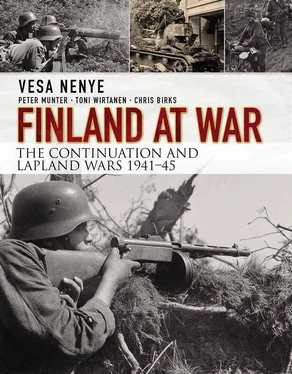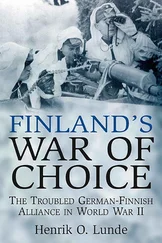The Karelian Army takes Petroskoi. The city is renamed Äänislinna.
2 October
Finnish forces push past Petroskoi to secure the region. They cross the narrows of the Suojunjoki River, and reach the bridge at Besovets. They also take Koskenkyä village.
3 October
Hitler gives a radio speech announcing that the Soviet Union has once and for all been defeated, and that it will never rise again.
6 October
Finnish troops initially refuse to cross the Syvärinniska River.
7 October
The Finnish 7th Division crosses the Syvärinniska tributary on the eastern edge, by Lake Ääninen. Munjärvi village is captured by Colonel Oinonen’s Group O.
14 October
Parts of the 7th Division head east, cross the river Syvärinniska and meet the vanguard of the Soviet 114th Rifle Division, freshly transferred from Siberia. This meeting defines the front line for the remaining years of the war.
19 October
Group O reaches its objectives in northern Karelia, secures the Munjärvi area and defeats the Soviet 71st Rifle Division.
26 October
The Finnish 8th Division connects with Raappana’s 14th Division and forms a unified front. They settle into trench positions.
27 October
The coastal defences in the Petroskoi area are secured and handed over to the newly formed Äänisjärvi Coastal Brigade.
1 November
Siilasvuo’s III Army Corps attacks again towards Louhi and the Murmansk railway.
5 November
President Ryti informs Mannerheim that discharging parts of the army to return to civilian duty is vital for the infrastructure of the country.
6 November
Mannerheim starts to plan a third line of defence between lakes Seesjärvi and Ääninen. He also orders the formation of II Army Corps under Major-General Taavetti Laatikainen.
17 November
Siilasvuo gives orders to halt III Army Corps’ attack on Louhi. The Murmansk railway is not reached.
17 November
Group O enters the deserted village of Perälahti without a fight.
23 November
The 8th Division of II Army Corps captures Karjalan Maaselkä by Lake Seesjärvi.
25 November
Finland joins the Anti-Comintern Pact.
28 November
Mannerheim proposes the first discharge of parts of the army.
30 November
The German offensive halts at the gates of Moscow.
2 December
The Soviets abandon the Hanko naval base under the cover of darkness.
5 December
Finnish forces take the town of Karhumäki.
6 December
Poventsa village comes under Finnish control. This is as far as Mannerheim allows the front to be extended.
The Finns declare that territories lost in the Moscow Peace Treaty have now returned to Finland. Great Britain declares war on Finland.
7 December
Mannerheim orders the Karelian Army to take up defensive positions on the fronts on the Maaselkä Isthmus (along lakes Ääninen and Seesjärvi) and Aunus Isthmus (along the Syväri River). A prolonged period of trench warfare starts.
8 December
The United States and Great Britain declare war on Japan. In a belated attempt to prevent further Finnish advances, the Soviets blow up the locks of the Stalin Canal, flooding the town of Poventsa.
1 January
The Soviet Navy attacks Finnish islands. The Red Army attacks towards Krivi on the Maaselkä Isthmus.
5 January
President Ryti receives news of Soviet peace terms, presented to the British foreign minister by Stalin.
14 January
Formation of the mostly German Army Command Lapland (AOK Lappland), and relief of the Finnish troops under Army Command Norway. Finnish Major Arnold Majewki leads an attack to sabotage the Murmansk railway at Maiguba.
19 January
Majewski’s sabotage mission destroys a section of railway, and the troops make their return to Finnish territory.
21 January
Mannerheim warns Ryti of a possible German collapse on the Eastern Front. Japan invades Burma. The Soviet Navy manages to capture the station at Krivi.
3 February
Mannerheim informs Germany that, unless its position on the Eastern Front improves, he will abandon the attack on the Murmansk railway.
7 February
The Soviets are ejected from Krivi by Laatikainen’s II Army Corps. A surprise attack by Soviet ski-troops attempts to take the town of Poventsa, but is repelled after a week.
10 February
Finnish headquarters upgrades the Tank Battalion to an armoured brigade. In June the unit is combined with the 1st Jäger Brigade to form the Armoured Division.
27–28 March
Finnish forces perform a daring crossing of the frozen Gulf of Finland to capture Suursaari Island from the Soviets.
28–29 March
The Royal Air Force bombs Cologne (Köln).
30 March
The Finnish Army occupies Tytärsaari Island. The Germans agree to garrison it.
5 April
Hitler orders a shift in focus on the Eastern Front towards Stalingrad and the Caucasus.
8 April
A Soviet attack on the garrison on Tytärsaari is repelled.
9 April
US troops surrender on Bataan in the Philippines.
10 April
Finnish troops depart Tytärsaari, and the German garrison takes over.
11 April
The Soviet attack on the Syväri River marks the beginning of the rasputitsa battles.
21 April
Finnish forces recapture the Syväri River breach during the rasputitsa battles.
24 April
Soviet forces attack from Kiestinki.
7 May
The Soviet encirclement at Kiestinki is contained by the Finns.
8 May
German troops begin an offensive in the Crimea.
12 May
The Soviet Union begins a spring offensive south towards Kharkov.
22 May
The Finnish and German navies begin building a mine blockade, forcing the Soviet Navy into a small corner of the Gulf of Finland.
24 May
The second phase of the rasputitsa battles, at Kiestinki, ends after a month of fierce fighting with a defensive victory for III Army Corps.
26 May
Great Britain and the Soviet Union sign the Anglo-Soviet Treaty. A German–Italian force attacks towards El Alamein on the Egyptian border.
30–31 May
The Royal Air Force launches a major raid on Cologne.
3 June
German troops attack Sevastopol in the Crimea.
4 June
Hitler visits Finland on Mannerheim’s 75th birthday.
27 June
Mannerheim departs for a visit to Germany.
28 June
German forces launch a broad attack on the Don front.
1 July
The German XVIII Mountain Corps relieves Finnish forces on the Lapland front. The 3rd Division takes responsibility for the area south of Uhtua. German troops take Sevastopol in the Crimea.
23 July
Hitler orders preparations for the taking of Leningrad.
27 July
The Germans take Rostov at the mouth of the Don River.
29 July
Читать дальше












